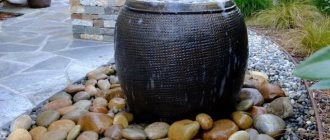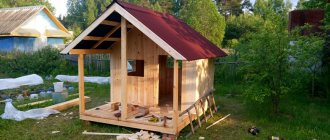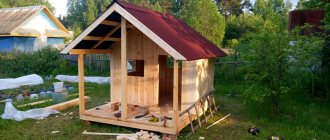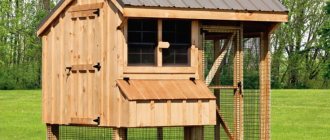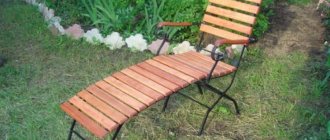It seems that the days have passed when Russians’ summer cottages and private courtyards were exclusively an area with laid out beds and planted trees and shrubs. A modern garden plot, a large private yard or a tiny backyard within an urban home can become a work of landscape art. Beautiful flower beds, neat garden paths, barbecue areas, swings and gazebos - there are plenty of options for arranging even modest-sized yards. But according to the Japanese - great specialists in creating ideal landscape design - for a harmonious environment in your yard or summer cottage, three components must be present: plants, stones and water. This publication will be devoted to the introduction of a source of water into the arrangement of the local area. Let's look at possible options for creating a fountain on a summer cottage or in a personal plot, within a small courtyard or a huge local area.
Options for fountains and waterfalls for a summer cottage
Fountain device
From the very beginning it may seem that making a small fountain is very difficult, but this is not entirely true. Of course, there are also complex hydraulic structures, but for the dacha they choose simple models that you don’t have to spend a lot on, since you can use improvised means for the work.
The main difficulty in manufacturing is its decoration.
All fountains have two types:
- Closed - in them water constantly circulates in a circle. The pump is installed in the main tank and supplies water from there to the pipeline system. The pressure in it is created only by pumping equipment.
- Open - water enters such a system from foreign sources. The source can be a natural reservoir or river, or the water supply system of a country house. The pressure in such a system can be created by the pressure drop in the system due to physical laws. We will talk about this in more detail below.
A garden fountain for a summer cottage is an oasis on the territory of a summer cottage.
In gardens, the first option is often built, since they are easy to maintain and simpler in structure. In this case, water must be periodically topped up (it evaporates and splashes) and cleaned (filtration equipment is installed). Sometimes they even perform a complete pumping out and replacement.
Open models require a water supply system and a water removal system. Good drainage and devices that control the filling level of the main tank are required.
Interesting to know! Water from a flowing fountain can be used to water plants, but it is not required around the clock, so such a fountain will have to be turned off at some intervals.
An example of an open option without a tank - water goes into the ground through the drainage system
Therefore, let’s continue to talk specifically about closed fountains, because they are preferred by the majority (read the article about the types of fountains for dachas).
How to make a fountain bowl
If you need a classic shape - a round, square or oval bowl from which a stream of water flows, the easiest way to find a suitable plastic tank. They come in different shapes and volumes - from tens of liters to several tons. In color they are mainly black and blue. Although it seems that for our purposes it is better to take a blue color, keep in mind that against such a background the pollution is more visible. To prevent your fountain from looking like a swamp, you will have to clean this bowl often. From this point of view, it is more practical to take black - the water looks the same, but you need to wash it less often.
Garden fountain made of plastic bowl
The selected tank can either be buried flush with the ground level, or leave a side. Most often, the sides are decorated with stone or pebbles. Depending on this, choose the depth of the pit. It is dug out and is slightly larger than a bowl.
You can read about how and with what you can decorate the site here.
When the required depth is reached, all the stones, roots, snags are removed, the bottom is leveled, compacted, sand is added in a layer of about 10 cm. It is well leveled and spilled so that it becomes compacted. Place the bowl on the prepared base and fill it with water. Sand or soil is poured into the gap between the walls of the bowl and the pit. Sand - if the soil is clayey, and soil - if it drains normally. Having filled in a small layer, it is compacted - carefully, using a pole or deck to get into the gap to be filled. But no matter how well you compact, be prepared for the fact that in a couple of weeks you will have to add more: the soil will shrink by several centimeters.
The bowl protrudes above the ground level
You can do without a plastic bowl. There are two other options: make the tank from monolithic concrete. In this case, you can make a fountain with sides. The process is long and expensive, and you also need to worry about waterproofing.
The cheapest option is to dig a pit and line it with film. In principle, any high-density polyethylene will do, but it will last a year, maybe two. Then it begins to let water through. Special films for swimming pools are more reliable in this regard, but they cost a lot of money, but can be used for years. The technology for making such a fountain bowl is captured in the photo.
Pit marking and excavation work
The first stage is digging a pit and leveling the walls. After the required shape and dimensions are achieved, the horizontal areas are leveled and covered with a layer of sand. It will protect the film from possible damage.
We lay the film in the finished pit. It should lie inside without tension, freely. Its edges are covered with soil and pressed down with boulders. To prevent plant roots from growing through the film, it is not advisable to lay geotextiles underneath. This is a non-woven fabric that is very tear resistant. It is used when laying roads to prevent the soil from being crushed and trees from sprouting. So she can protect the fountain without difficulty.
Laying film in the pit
Boulders are laid out on the laid film. If the pit is stepped, boulders should lie on each step. When the design of the bowl is almost complete, a pump is installed. The bowl is filled with water and the bowl is tested for leaks and pump performance.
The film laid in the pit is decorated with boulders. After installing the pump
Actually, that’s it, if the electricity is supplied, you can start the fountain.
Basic elements of an indoor fountain
A closed fountain has 3 main elements, which will be discussed in this chapter.
Fountain pump
The heart of such a fountain is an electric pump that pumps water through the system. The operating mode of the entire structure will depend on its parameters.
A fountain for a pond in a country house is cascading - powerful pumping equipment is required to organize a waterfall
- For fountains, they sell special pumping stations, consisting of the pump itself and filtration equipment. The filter protects the pump from damage by small particles of stones, sand, and organic matter, and at the same time is responsible for purifying the water in the tank. It needs to be cleaned or replaced at some intervals.
Attention! A clogged filter causes a drop in pressure in the system. The pump begins to wear out and gets very hot. This mode of operation will lead to rapid failure, which is why it is so important to inspect the equipment in a timely manner. For the same reason, stones are not placed around the filter, since the effective suction area is reduced.
- The structure of pumping equipment varies. There are submersible models, and there are ground-based ones, which are mounted in special boxes and disguised as the surrounding landscape. The last option is easier to maintain.
All equipment is housed in one building
- The pumping station can be in the form of separately spaced units, or everything can be installed in one compact housing. The configuration is selected according to the shape of the reservoir and its size.
- The equipment also comes with a water supply system and a set of nozzles that allow you to change the shape and height of the jet.
Set of pumping equipment with replaceable nozzles
- The pumps can be powered from a 220V public network or from solar panels - the second option is more economical, but it cannot be called stable. You can, of course, provide a battery in case of cloudy weather, but its capacity may not be enough to maintain normal operation, and the cost of the solution increases.
Attention! If you connect a submersible pump to the network, you need to be careful and follow all technological standards prescribed by the manufacturer. The power cable must be insulated and connected to a protection system consisting of RCDs and other circuit breakers.
Operating principle of a submersible pump
When choosing a pump, consider the following parameters:
- The power of the equipment will tell us how much water it will pump per hour. This is important for pumps operating in waterfall mode.
- Continuous operation time - if the pump periodically needs to be turned off for rest, then it is unlikely to be suitable for a normal fountain.
- Availability of an overheating protection system. Since the pump is cooled by water passing through it, a clogged filter can cause serious overheating (does not apply to all types of equipment). It would be good if there is a temperature sensor inside, which will protect the station from damage.
- Also look at power consumption. No one will be happy if tens of kilowatts of energy are generated per day.
Choosing a place for a fountain
The correct location of the fountain not only ensures maximum decorativeness of the structure, but also makes it easier to care for during operation. If the fountain is located in a completely open area, which is actively heated by the sun, the water will evaporate and bloom faster.
You cannot build a pond with a fountain next to trees and deciduous shrubs. Firstly, this will lead to damage to the pond bowl by the roots, and secondly, leaves, small twigs and other debris will get into the water. In such conditions, filters quickly become clogged and fail, and the water becomes cloudy and acquires a putrid odor.
Choosing a location for a fountain is of great importance
The fountain should be located on the leeward side and no closer than half a meter from buildings and garden furniture. Due to splashes and water spray, the surfaces will always be wet, which will lead to the development of fungus and the gradual destruction of materials. But you shouldn’t place the fountain too far from the house either. Electricity is required to connect the pump, and a cable that is too long causes additional inconvenience and expense. A backlit fountain looks very impressive, and for this it is also necessary that the energy source be at the optimal distance from the reservoir.
The illuminated fountain looks very impressive
And last but not least, the fountain must have a decorative background and be clearly visible from different corners of the site. It makes no sense to install such a structure if there is no opportunity to admire it and show it to guests.
A decorative fountain should be located in a visible place
Building a fountain at your dacha with your own hands
Now let's look at how fountain equipment is installed using two examples - a ready-made solution from a store and a homemade one.
How to make a fountain with your own hands - place for installation
Work begins with choosing the installation location. Usually they try to choose the most noticeable and picturesque place on the site.
Without a purification system, the water in the fountain will quickly bloom
You also need to take into account the following factors:
- You should not install the structure at a point that is exposed to direct sunlight for more than 6 hours a day, otherwise the water will actively evaporate, and due to heating, the water will actively bloom.
- The close proximity of large trees is also undesirable, since their root system can damage the waterproofing of the bowl. They will also constantly shed leaves and branches that will rot in the water.
- The fountain is also not placed very close to the house, so that water does not fall on the walls.
- The place should be sheltered from the wind so that it does not disrupt the jets.
The area for the fountain should be landscaped, with lush, low-growing vegetation.
Pond with a fountain in the country - store kit
So, let's start installation. Before us is a ready-made structure that only needs to be assembled. What steps does the step-by-step instruction include:
- The first stage is installing a plastic container in the ground. It is necessary to do this. So that the sides are slightly higher than the ground and less dirt gets inside. Around it is filled with crushed stone or small pebbles.
Do-it-yourself fountain at the dacha - installing a pump
- Next, a pump is installed - it has suction cups so that it is securely fixed to the bottom of the tank.
Laying decorative stone
- Stones are placed on the bottom to give the container a natural look.
Filling with water
- Water is poured into the reservoir. It should be enough to completely cover the pump housing by a few centimeters. We remember that it is the liquid that cools it.
Fountain decoration
- We decorate the fountain as your imagination dictates. You can use various minerals, artificial and natural plants, as well as various garden decor.
A small fountain is started.
We start the pump and rejoice at the result. As you can see, everything is extremely simple to do.
How to build a fountain in a country house from concrete
We bring to your attention an interesting fountain made from scrap materials.
Creating a Shape to Fill
- Take a piece of plywood and place it on the ground. It will serve as a working platform for us. We form the formwork for our fountain. For this you will need a small plastic bucket. Make a hole in the bottom in the center and insert a piece of plastic pipe into it.
Cardboard formwork
- We take a piece of paper tube and put it on top - this will be the external formwork. Pour concrete from above to the very edge and bayonet it with a stick. Reinforcement can be provided to strengthen the structure.
- We do the same thing, only we take the lampshade from the lamp as formwork. We insert the same plastic pipe directly into the concrete, sealing its lower end with tape so that concrete does not get inside.
Pouring a concrete ball
- We secure the pipe with tape so that it does not float up.
Fixing the pipe
- Once the concrete has hardened, the outer formwork will need to be removed. Be careful with the glass, first wrap everything with film and carefully break it with a hammer. The cardboard is simply cut with a knife.
- All protruding parts of the pipes are cut off with a file. The ball is pierced with tape that was used to cover the end of the pipe.
- The fountain's container is buried in the ground. A pump is installed in it, then everything is carefully filled with stones.
Installation of the container
- A hose is connected to the pump outlet, which is then threaded into a pipe embedded in a concrete cylinder. The same is done with the ball. The hose is shortened so that it does not stick out. After this, the concrete parts are secured with silicone.
Base installation
- Stones are added to completely hide the container and water is poured into the system.
Working homemade fountain
Now you can turn on the pump and admire the result.
Types of fountains for landscape design of a site
The generally accepted opinion that a fountain in a summer cottage is expensive, labor-intensive and generally troublesome has long been unfounded. Organizing a source with constantly circulating water on your own is not difficult if you approach the issue with care and accuracy. Well, there are so many ready-made options in modern stores that it’s easy to get confused.
Choosing a fountain, like any device for decorating a local area, requires precise calculations and the correct selection of shapes, sizes and materials. Before you go to the store or on the Internet in search of videos with master classes on making a fountain with your own hands, you need to decide what types of fountains are and how they differ from each other.
Submersible fountain
This type of fountain can be considered the simplest in terms of design and installation. The peculiarity of the submersible mechanism is that the jet shoots directly from the water. But this option requires the presence or creation of a small reservoir - an artificial pond or a large bowl of water that is immersed in the soil. The submersible version of the fountain is one of the least expensive. It is enough to select a suitable spray nozzle that forms a jet and fix the hose from the pump. There is no need to install additional technical devices.
Stationary fountain
These are the designs we imagine most often when we talk about fountains in parks and squares. This type of fountain requires the presence of some decorative elements that imitate a water source. A stationary fountain for a summer house or private courtyard can use jets, sculptures or their compositions, and various elements of landscape decor.
The design of a stationary fountain itself is somewhat more complex than a submersible type mechanism, but such a decorative element of landscape design also looks more respectable and impressive. This is especially true in cases where it was possible to find a fountain model that fits the overall design concept of the site (or make it yourself).
Among the many models of stationary fountains, products made from polymer material, which perfectly imitates natural stone, are especially popular today. Products made from polystone externally look like models made from natural stone, but at the same time they cost significantly less, are lightweight and easy to install and operate.
Fountains made of polystone can be either one object or a composition of several elements - there are countless options. In any case, the material is not subject to rotting or deformation, and is able to withstand jets of water even under fairly high pressure.
Fountains in which water flows over the main element or a whole composition of objects look stylish, modern and creative. It seems that the stone itself is a source of moisture. Meanwhile, water flows through a hose, which is located in the center of the hole of the boulder (or any other decorative element).
Fountain-waterfall “falling water”
There are no less varieties of fountains that imitate both jets and water falling from something like a waterfall. In such a combined composition, the fountain jets, rising upward, do not easily fall back into the water, but end up on a cascade of stones or stepped decorative elements.

